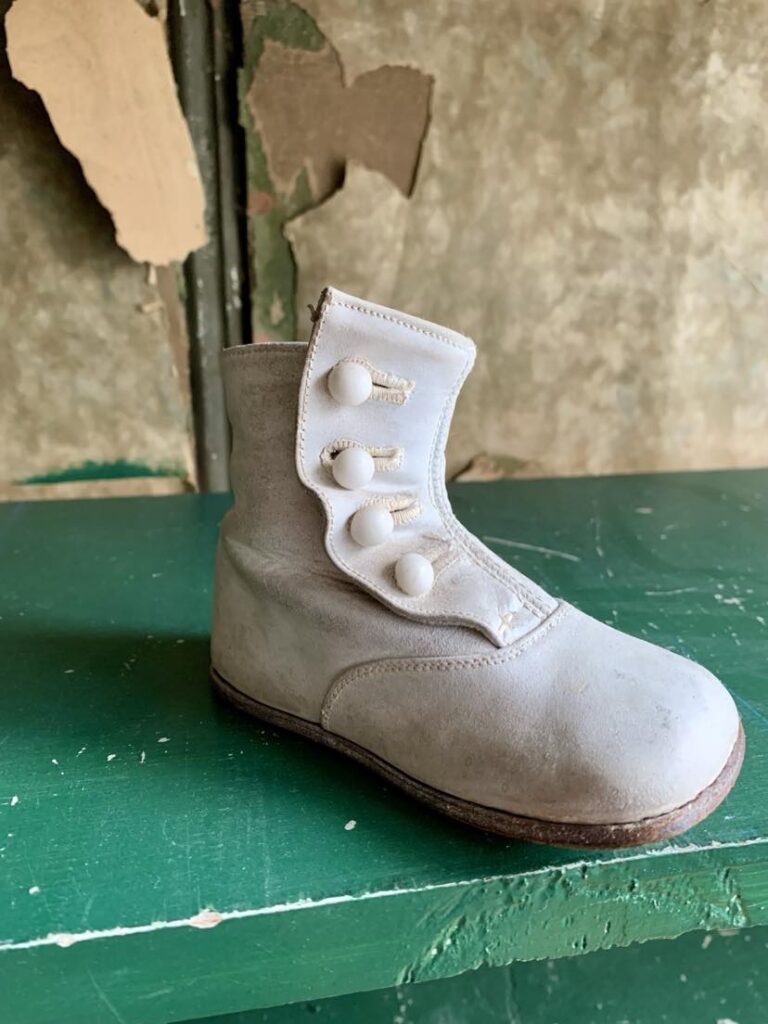by Gail Blass Wolczanski
The bell suspended above the doorway to Brown’s shoe store jingled as each one arrived.
The shelves were nearly bare, revealing aged, faded, and cracked walls. A plastered over doorway that once led upstairs looked jailed behind the horizontal boards. The floors, too worn thin from well over a century of foot traffic, were past restoration. Unsold boots were allocated for donation to Veterans and fixtures had been sold. She was sitting by the storefront window prepared to retire but, at her friend’s suggestion, was at the empty store to donate some items to the care of the historical society.
Judy Rundell had wanted the landmark village shoe store to continue its service to the village but no buyers came forward. On the counter was what was left of children’s shoes. They had been purchased from her en masse. In a separate box near the storefront were a dated small pair of white children’s shoes as well as a pair of lady’s button up shoes from the very early 20th century to be retained and treasured. In 1902, when Mr. Mather was proprietor, he carried a diverse stock of shoes and boots and claimed to be the most reliable shoe store in the east. Were these shoes part of the inventory?
In 1927, Mr. Julius Brown moved his part of his family shoe store business from Albany to Chatham buying Mather’s shoe store and the Main Street building it housed. What prompted this move was the predominant railroad industry in the village. Railroad workers representing multiple rail lines would travel to Albany to purchase their railroad work shoes. So, Brown brought the shoes to them. Even if the owners were taking a break on the second floor living area, he or his wife could hear the bell tripped by a customer entering and go directly down into the store to serve.
It was the era when shoes were fitted. Once a selection or two was made, he would sit you down, pull up his stool and remove your shoe placing your foot on the angled foot rest.

Did you know your size? School children’s feet were inevitably measured by standing up on the metal foot scale first used in 1872. The new shoes were placed on your feet and you were observed walking back and forth. “Do your toes touch?,” mothers would ask. During the Great Depression, children who faced returning to school with outgrown shoes were saved by the generosity of Julius Brown.

Decades of customers purchased fine footwear there, and some utilized the shoe-fitting fluoroscope (X-ray machine) he acquired. It was believed children’s shoes lasted longer if fitted with it.
For the thrill of seeing the bones of your feet, some tried out the fluoroscope on a regular basis well into the 1950s even though health warnings were shared in 1946 to limit exposure. And no customers were lost for decades through his retirement and then his successor’s, Murray Rosen, (his son-in-law).
Into this historic setting, Judith Rundell set her business acumen. Villagers and even those who came from elsewhere found quality in shoes and clothing she offered for close to 24 years. She was honored to carry on the history of Brown’s Emporium and sad to have to close without a buyer coming forward to carry the legacy into the future. But, with the encouragement of her friend, Susan Acciani, Judy has allowed The Chatham Village Historical Society to secure tidbits of what was: the carved “Brown’s” sign that hung over the entrance, the wooden seats originally secured from Cady Hall Opera House when it closed, and the advertisement for children’s shoes as well as the antique shoes and foot measure previously mentioned. On the melancholy day that these items were acquired, Judy spoke of the dozens of railroad shoes she had tossed out (to our chagrin). When asked if her well-known customer, Al Roker, would miss her she smiled wistfully. “He would come in Saturdays and pick up a dozen eggs. I raised chickens. He said on a broadcast that he lived in an upstate town where he got his eggs in a shoe store.”
April 2024 draws an end to another long-established business enterprise for Chatham Village.
The Chatham Village Historical Society hasn’t the means to save them, but the members make every effort to secure items that trigger memories of their existence and the influence former business owners had on our lives.








Recent posts:
